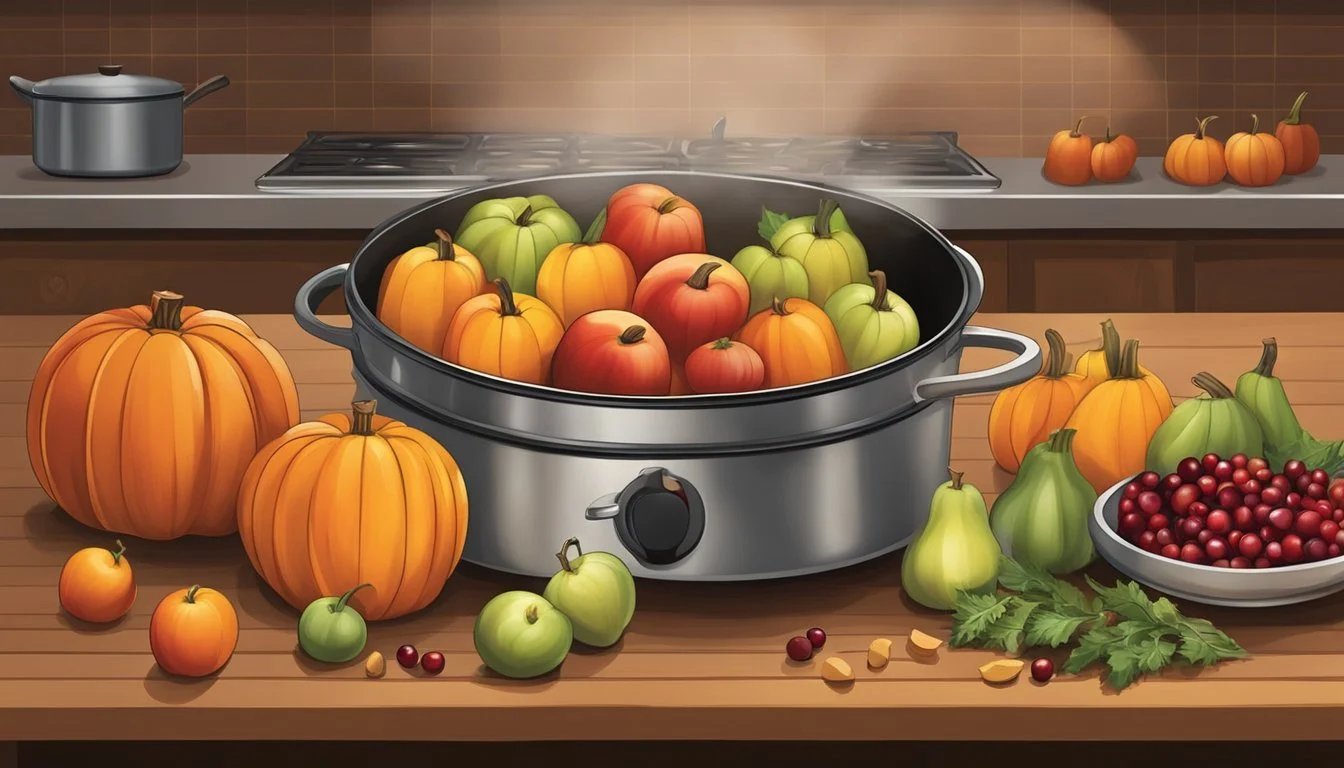Maryland Seasonal Fruit & Vegetables in November
Guide to Fresh Produce Selection
This Article is Part of our Maryland Seasonal Fruit & Veg Calendar
Maryland's November harvest offers a rich tapestry of flavors as the state transitions into the cooler months. This period marks the final stretch for local farmers to deliver the last of autumn's bounty before the winter sets in. The focus on seasonal produce ensures that consumers have access to fruits (What wine goes well with fruit?) and vegetables at the peak of their freshness and nutritional value.
In November, Marylanders can take advantage of a variety of seasonal vegetables such as brussels sprouts (how long do brussels sprouts last?), cabbage, and carrots (how long do carrots last?), which are known for their enhanced sweetness when matured in cooler temperatures. Root vegetables like turnips and sweet potatoes (What wine goes well with sweet potatoes?) also grace the tables with their hearty textures and robust flavors, ideal for comforting fall dishes.
The fruit selection, while more limited compared to the summer months, includes crisp apples and pears, which continue to be harvested. These fruits are not only perfect for fresh eating but also for creating warm, spiced desserts that are synonymous with the season's festivities. The emphasis on local and seasonal produce in November reflects Maryland's commitment to sustainable agriculture and community support for local farms.
Understanding Maryland's Seasons
Maryland's climate and its impact on agriculture lead to distinct growing seasons. Each season plays a critical role in determining the availability of fruits and vegetables throughout the year.
The Role of Weather in Crop Availability
Maryland experiences four distinct seasons: spring, summer, fall, and winter. The harvest season typically peaks in the summer and fall months when the weather is warm and conducive to growing a variety of crops. Winter in Maryland often means a decrease in local crop availability, as colder temperatures and potential frosts make it challenging for many plants to survive. However, some hardy vegetables can still thrive.
Summer crops (June through August):
Tomatoes
Sweet corn
Peaches
Fall crops (September through November):
Brussels sprouts
Apples
Pumpkins
Winter crops (December through February):
Stored root vegetables like potatoes
Some greenhouse-grown produce
Transitioning from Fall to Winter
As Maryland transitions from the bountiful fall to the colder winter, farmers prepare to switch their crops accordingly. November marks the tail end of the harvest season, where late fall crops are gathered and storage methods are utilized to extend their availability. Crops such as Brussels sprouts and root vegetables like carrots have their harvesting peak around this time, thanks to their resilience to the cooling temperatures.
Fall to Winter transition crops (harvested in November):
Brussels sprouts
Carrots
Cabbages
Maryland's farmers rely on a keen understanding of seasonal weather patterns to plan their crops, ensuring a year-round supply of fresh, local produce to the community.
Key Seasonal Produce in November
November in Maryland heralds a bounty of robust root vegetables and hearty greens, while also offering the last picks of certain late fall fruits. As the temperatures drop, these seasonal produces become staples in local cuisine.
Harvesting Root Vegetables
The soil of Maryland yields a variety of root vegetables in November. Potatoes, essential for their versatility, reach their harvesting peak. Beets, known for their earthy flavor and nutritional value, are also gathered during this month. Turnips, often underappreciated, add a piquant taste to autumnal dishes. Lastly, Pumpkin, the emblem of fall, is readily available and used in everything from culinary creations to festive decorations.
Late Season Greens and Herbs
Beyond the roots, Maryland's November fields are rich with leafy greens. Cabbage stands out for its ability to withstand cooler temperatures and shines in seasonal recipes. Kale, the hardy and nutrient-packed green, remains a favorite for cold-weather meals.
Fruits Available in Late Fall
Fruit harvests are winding down by late fall, but a few varieties are still prominently featured. Apples and pears, which store well through the winter, can still be found. Apples retain their crispness and variety, making them perfect for both eating raw and cooking. Pears offer a soft contrast, with juicy flesh that is ideal for both sweet and savory applications.
Though the fall harvest is nearing its end, these fruits and vegetables offer a wealth of flavors and culinary possibilities for the season.
Maryland's Fruit Harvest
November in Maryland brings the tail end of the autumn harvest, offering a final bounty of fresh fruit before winter sets in. Fruit enthusiasts can still find a variety of fresh produce that's ripe for the picking.
Late Harvest Fruits
Cranberries: Renowned for their tart flavor, cranberries are typically harvested in October, but their availability extends into November. They are often found in bogs and marshes across Maryland.
Apples: Several apple varieties have a late harvest season in Maryland. These crisp, juicy fruits are still available in orchards and markets.
Fuji: Known for their sweet flavor and firm texture.
Granny Smith: A tart apple that is versatile for both eating fresh and cooking.
Pears: Like apples, pears are a delectable fruit that can often be harvested in Maryland through November.
Bosc: These pears are recognized by their brown skin and sweet, spicy flavor.
Anjou: An all-purpose pear known for its mild, sweet taste and juicy flesh.
While the frost-sensitive fruits are now out of season, these hardier varieties offer a last taste of fresh, locally sourced produce before the winter scarcity.
Storing and Preserving Fruits
Proper storage and preservation can extend the enjoyment of November's fruit harvest. Here are methods to keep them fresh:
Apples: Store in a cool, dark place or refrigerate to slow down ripening. Apples can last several weeks when stored properly.
Pears: Unlike apples, pears can be ripened at room temperature. Once ripe, refrigerate them to maintain freshness.
Cranberries: These berries can be refrigerated to extend their shelf life and can also be frozen for later use.
For those seeking to enjoy the flavors year-round, canning and making preserves are excellent methods to capture the essence of these fruits. Jams, jellies, and sauces made from apples, pears, and cranberries provide a taste of Maryland's November harvest well into the colder months.
Popular Vegetables in Maryland's November
In November, residents of Maryland have access to a variety of cold-tolerant vegetables that are both nutritious and flavorful, adept at withstanding the region's chillier temperatures.
Hearty Vegetables for Cold Climates
Maryland's November gardens are robust with winter squash, varieties of which include butternut, acorn, and spaghetti squash. These squashes are revered for their thick skins and long shelf lives. Brussels sprouts also thrive in cooler weather, often sweetening after a frost. In terms of root vegetables, sweet potatoes are a popular choice, with their high vitamin content and versatile use in recipes from savory to sweet.
Vegetable Features Shelf Life Winter Squash Variety includes butternut, acorn; high in fiber Several months Brussels Sprouts Improve in flavor after frost; high in vitamins K and C Several weeks Sweet Potatoes High in vitamins A and C; versatile in cooking Up to a month
Tips for Choosing Quality Produce
When selecting winter squash, buyers should look for firm, heavy specimens with a dull, matte finish; a shiny exterior may indicate it was picked too early. For Brussels sprouts, it's recommended to choose bright green heads that are firm and compact. As for sweet potatoes, they should be smooth and free of bruises, with a firm texture. November is also an ideal time for purchasing pumpkins in Maryland, with the best choices being those with consistent coloring and no soft spots.
Note about Pumpkins: Although not a table, here is a tip for readers regarding pumpkins. When choosing pumpkins, whether for cooking or carving, one should opt for those with a deep orange color, which indicates ripeness, and ensure that the stem is still intact, which can help improve longevity.
Local Markets and Produce Availability
In November, Maryland's local markets are brimming with a variety of seasonal produce. Residents can explore several avenues to purchase fresh, locally-grown fruits and vegetables. Below are some resources to find these items.
Finding a Farmers' Market Near You
Maryland hosts numerous farmers' markets across the state that offer a diverse selection of November harvest. Shoppers can find Brussels sprouts, cauliflower, and celeriac during this time. To locate a market, the Maryland Department of Agriculture provides an online directory, or one may visit the Maryland's Best website for market schedules and locations.
Community Supported Agriculture (CSA)
A CSA allows individuals to purchase a "share" of the harvest directly from local farms. Participating in a CSA during November can provide a consistent supply of seasonal produce like cabbage and carrots. Each farm offers different varieties and pick-up options, details of which are listed in state directories for CSAs.
Supermarket vs. Local Produce
While supermarkets stock fruits and vegetables year-round, local produce in November has the benefit of being picked at peak freshness. Maryland's supermarkets may also carry local items, discernible by the "Marylands Best" label, ensuring consumers are supporting local farmers and getting seasonal products. However, farmers' markets and CSAs typically provide a more direct farm-to-table experience.
Cooking and Recipes
The chilly November in Maryland offers an abundance of seasonal produce ideal for hearty meals, preservation, and holiday feasts. Utilizing these ingredients not only supports local agriculture but also ensures peak flavor and nutrition.
Seasonal Recipes for November
During November, Maryland kitchens brim with the rich flavors of autumnal produce. Hearty squash can be transformed into creamy soups or baked as a sweet side dish spiced with cinnamon and nutmeg (how long does nutmeg last?). Pumpkins are versatile and can be used in pies or savory recipes, such as pumpkin risotto. Apples, another staple, shine in homemade apple crisps or chutneys, which accompany roasted meats (What wine goes well with roasted meats?) perfectly.
Canning and Preserving Techniques
Preservation in November allows one to savor the flavors of Maryland's harvest year-round. Apples yield a delicious jam, while pumpkins can be canned and saved for future pie fillings. Salsa made from the last of the season's tomatoes provides a burst of summer in the colder months. Canning vegetables like beets and brussels sprouts is also common, with the proper sterilization and storage techniques ensuring safety and taste.
Preparing Holiday Meals with Seasonal Produce
As holidays approach, incorporating local produce into celebratory meals becomes essential. Roasted vegetables, such as brussels sprouts and carrots, bring warmth to the holiday table. Stuffings enriched with apples and aromatic herbs elevate the traditional turkey dinner (What wine goes well with turkey dinner?). Sides of baked squash and pureed pumpkin add both color and comfort to any feast.
Agricultural Practices in Maryland
Maryland's agricultural practices are rooted in innovation and adaptation, focusing on sustainability and strategic crop management. The state's rigorous nutrient management planning is aimed at aligning with current agricultural regulations and environmental goals.
Sustainable Farming Methods
Sustainable farming methods in Maryland prioritize the health of both the environment and the crops. The University of Maryland Extension has enhanced nutrient management planning to integrate modern farming practices that support these sustainable efforts. They recommend precise fertilizer applications tailored to the needs of each crop, which reduces runoff into the Chesapeake Bay and adheres to the state's stringent environmental regulations.
Key Sustainable Practices:
Use of cover crops to enhance soil health
Integrated pest management to minimize chemical use
Conservation tillage to preserve soil structure and biodiversity
Crop Rotation and Seasonal Planting
Maryland farmers implement crop rotation to maintain soil fertility and to control pests and diseases. Rotating different crops each season reduces the need for synthetic fertilizers and pesticides, which is beneficial for the environment.
Seasonal Planting and Harvest Dates:
Vegetables are planted according to a carefully planned calendar that takes into account the local climate and soil conditions.
Harvest dates are meticulously scheduled to ensure peak freshness and quality. For example, root vegetables such as beets, carrots, and sweet potatoes are typically harvested in the fall, with some final pickings occurring in November before the winter sets in.
By following these practices, Maryland farmers successfully produce a diverse range of crops while also conserving the state's natural resources.
Conclusion
In Maryland, the month of November is characterized by a shift towards heartier produce. Residents embrace the seasonal transition by incorporating these items into their meals. Eating seasonally not only supports local farmers but also ensures that consumers enjoy the freshest possible flavors.
Produce available in November includes a range of vegetables well-suited for comforting autumnal dishes. They can expect to find:
Root Vegetables: Carrots and beets are stalwarts of the November harvest. Their earthy sweetness intensifies when roasted, making them ideal for side dishes.
Leafy Greens: Kale and Swiss chard offer robust textures and flavors, perfect for salads or sautéed as warm sides.
Squashes: Butternut and acorn squash provide a versatile base for soups and purees, appreciated for their creamy texture and rich taste.
Brussels Sprouts: These become available for a brief period, ready to be paired with savory and sweet profiles in a variety of recipes.
Consumers can find this produce at local markets, where the connection between the land and table is celebrated. Seasonal eating is a virtuous cycle in Maryland; it invigorates the local economy, reduces environmental impact, and culminates in more nutritious meals. Those who choose to participate in this cycle during November—and throughout the year—reap the benefits of peak freshness and support the sustainability of Maryland's agricultural heritage.







